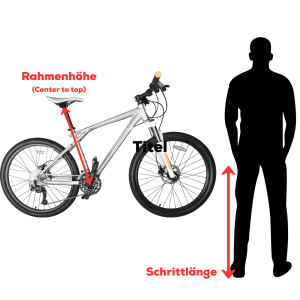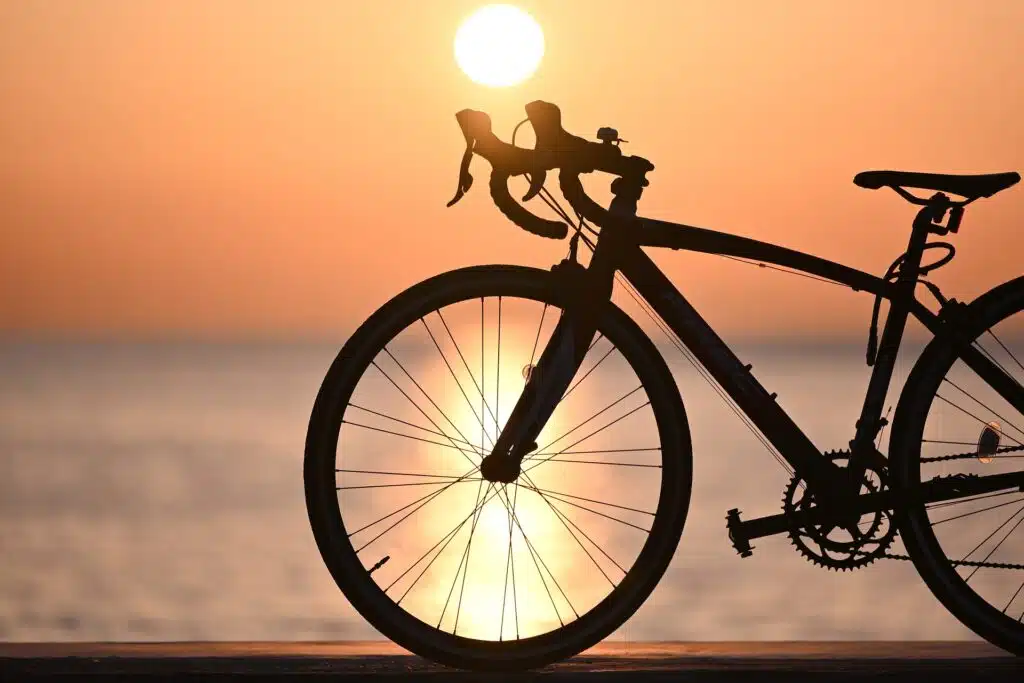Which bike suits me? This is a question everyone asks when searching for the ideal bicycle. Whether for fast city rides, sporty tours, or off-road adventures – the variety of bike types is huge. In this bike buying guide you’ll learn about the different types and categories of bicycles, which are best suited for your needs, and what to look for when purchasing to find the perfect bike for you.
What Types of Bikes Are There?
From road bikes to gravel bikes, the market offers countless types of bicycles. Below, you’ll find an overview of the differences between bike types and which purposes they are best suited for.
Which Bike Type Suits Your Needs? Finding the Perfect F
Do you just need a bike for commuting, or do you also want to go on countryside rides? And what about carrying luggage or taking on sporting challenges? Depending on your needs, different types of bicycles are optimized for different purposes. Here, we introduce you to the most common types and their best use cases.
Road Bike – Speed on Asphalt
Lightweight, aerodynamic, and built for high speeds: The road bike is the best choice for sporty riders on paved roads. It’s ideal for training, competitions, or fast commutes on smooth paths.


Mountain Bike – Perfect for Off-Road Adventures
If you want to tackle trails, forest paths, and steep descents, a mountain bike is the right choice. With thick tires, strong suspension, and a sturdy frame, it provides excellent grip and control on rough terrain.
There are two main types of mountain bikes:
- Full Suspension (Fully): Suspension on both the front and rear for maximum comfort, effectively absorbing shocks – ideal for technical trails and steep descents.
- Hardtail: Only the front fork is suspended, while the rear remains rigid. This makes it lighter, provides a more direct pedaling response, and is great for climbs or less demanding terrain.
Gravel Bike – Versatility On and Off the Road
A mix of road and mountain bikes, the gravel bike is perfect for long rides on mixed surfaces – from asphalt to gravel paths. Similar to a road bike, it is lightweight and has a sporty riding position, but with wider tires and a sturdier frame, making it great for adventures off of asphalt roads.


City Bike – Practical for Everyday Use
A city bike is comfortable, practical, and often equipped with fenders, a luggage rack, and lights. Perfect for commuting, shopping, or relaxed rides through the city. Comfort and individual style – whether chic, retro, or colorful – are key features of these bikes.
Trekking Bike or Touring Bike – Built for Long Distances
The touring bike is designed for long distances in any weather and at any time of day. It can handle almost any terrain and also light trails. The riding position is comfortable but slightly sportier than a city bike. A sturdy frame offers multiple mounting points for panniers, water bottles, and other accessories.


Cargo Bike – Transport Wonder on Two or Three Wheels
Whether for children, groceries, or larger items – a cargo bike can carry a lot. It’s especially popular in cities as a car alternative, though it’s less suited for long distances or rough terrain. Many cargo bikes also come with electric assistance.
Folding Bike – Compact and Flexible
A folding bike is ideal for commuters and anyone who needs a space-saving bicycle. Its folding mechanism makes it easy to transport on buses, trains, or in a car. It’s particularly useful for short city trips and a practical solution for commuters or campers. However, due to its foldable frame, it’s not as stable as a regular bike, so rougher terrain should be approached with caution.

Bike Categories: Key Differences Explained
Some manufacturers classify their bikes into different categories based on international standards (see the ASTM F2043-13 PDF here). These indicate how off-road capable a bike is and its intended use. Keep in mind that accessories like fenders, racks, or trailers can lower a bike’s category.
- Category 1: For paved roads (e.g., city or urban bikes).
- Category 2: Suitable for light trails and paths with small jumps or drops up to 15 cm, e.g., trekking bikes.
- Category 3: For more demanding trails and rough terrain with jumps up to 61 cm, e.g., cross-country bikes.
- Category 4: Suitable for downhill rides up to 40 km/h on rough terrain with jumps or drops up to 122 cm, e.g., mountain or trail bikes.
- Category 5: Extreme terrains and downhill speeds over 40 km/h, e.g., downhill or freeride bikes.
- Category 6: The german DIN institute defines a sixth category in their European standard (EN 17406, published 2021) for bikes meeting Category 1 requirements but designed for high-speed racing above 50 km/h, e.g., road or triathlon bikes.
What to Consider When Buying a Bike?
Buying a bike is an investment that requires careful thought. Whether for daily commuting, sports, or long-distance touring – the right model must suit your purpose, body size, and riding position. Here’s what to look for when making a purchase.
Bike Buying Guide: Key Factors to Consider
Before deciding on a bike, consider these important factors:
- Purpose: City rides, long tours, off-road trails, or sporty rides?
- Frame Material: Aluminum, steel, or carbon – each has its pros and cons regarding weight and durability.
- Gears: Derailleur gears offer more flexibility, while hub gears require less maintenance.
- Brakes: Rim brakes, disc brakes, or coaster brakes – your choice depends on riding style and weather conditions.
- Comfort & Ergonomics: The right riding position, handlebar shape, saddle type, and frame geometry determine comfort and handling.
The Most Important Step: The Test Ride
A bike must not only look good on paper but also feel comfortable. A test ride provides insight into riding comfort, geometry, and handling. Make sure you feel safe and comfortable on the bike.
Bike Frame Size: How to Choose the Right Fit
The right frame size is crucial for a comfortable and efficient ride. It depends on two factors: your inseam length and the type of bike. A larger frame size provides more stability for road bikes on long distances, while a smaller frame makes a mountain bike more agile.
To determine the right frame size for you, start by measuring your inseam length. Ideally, stand barefoot and in your underwear with your legs closed against a wall. Place a book horizontally between your legs and raise it until it firmly touches your crotch without pressing too hard. Then, use a measuring tape to measure the distance from the top edge of the book to the floor—this is your inseam length. Try to be as precise as possible, as just a few centimeters can make a big difference.
Once you have determined your inseam length, multiply it by the factor corresponding to your bike type:
- Road Bike: Inseam × 0.665
- Trekking & City Bike: Inseam × 0.66
- Mountain Bike: Inseam × 0.57
Many manufacturers offer frame size calculators on their websites. Alternatively, you can seek advice at a specialty store. A test ride is ultimately the best way to determine the right size.

Bike Wheel Size: Which One Is Best for You?
The wheel size, measured in inches, refers to the wheel diameter and affects the riding characteristics. The ideal size depends on both your height and the type of bike. Smaller diameters offer more agility and are space-saving, especially for folding bikes. Larger wheels provide better riding comfort. For adults, common sizes range from 26 to 29 inches, while children typically start with 12-inch wheels and move up as they grow.
- 28-inch: Standard for trekking, city, and road bikes – ensures stability and efficiency.
- 27.5 & 29-inch: Common for mountain bikes – 29-inch wheels offer more rolling comfort, while 27.5-inch wheels provide greater agility.
- 26-inch: Often found on folding bikes or older mountain bikes – compact and maneuverable.
- 16-20 inches or smaller: Compact wheels for folding bikes or children’s bikes.
E-Bike vs. Regular Bike: Bike Buying Guide
The decision between an e-bike and a traditional bike depends on fitness, terrain, and personal preference. This bike buying guide outlines the pros and cons.
E-Bike benefits
- Less effort: The motor assists your ride, making commutes sweat-free.
- Faster travel: Higher average speeds compared to traditional bikes
- Easy entry: The barrier is lower, making it easier for untrained individuals or people with pre-existing conditions such as knee problems to start cycling.
- Easier transport of goods or kids: E-cargo bikes offer great support
- Ideal for hills and wind: Provides extra power when needed
- Eco-friendly alternative to cars: Lower carbon footprint than cars or motorcycles.
Disadvantages of E-Bikes
- Higher cost: Prices range from $1,500 to $5,000.
- More weight: The motor and battery add weight, making them harder to transport and harder to ride when the battery is empty.
- Battery charging required: Battery range is typically 50–150 km, with a 3–6 hour recharge time.
- Increased maintenance: Motors, electronics and batteries require more servicing.
- Lower workout intensity: Less physical effort compared to a classic bike.
- Higher theft risk: Their value makes them attractive to thieves, often requiring extra insurance.
Conclusion: The Ultimate Bike Buying Guide
The right bike depends on your personal needs. Whether a road bike, mountain bike, or folding bike – each type offers unique advantages. A bike buying guide can help identify the ideal model. Pay attention to frame size, equipment, and handling. An e-bike can be a great alternative for comfortable and eco-friendly rides. No matter which bike you choose, a test ride is essential to finding your perfect match!
Sustainable Mobility – A Whole Weekend Without a Car
Giving up the car, our most frequently used mode of transportation, is certainly not easy for many. Especially for those living in rural areas, the car is often the only viable means of transport. Of course, there is also the bicycle, but try using it – unless you own a cargo bike – to do the family shopping when the nearest supermarket is 10 km away.
Cycling tips and training solutions
Cycling has long been a popular activity. For beginners and riders with more experience, the fun and benefits of cycling have been numerous. As a result, the global market for bicycles shows continuing growth, aiming to reach $34.6 billion by 2027! Even if you have not been on a bike before, now is time to […]
On the saddle: cycling sports
The bike is a versatile all-rounder and available in numerous versions. Some like it fast and ride road bike or gravel bike, others are looking for a little more action and use the mountain bike or BMX. In this article we present the different types of cycling. Surely there is something suitable for you.







